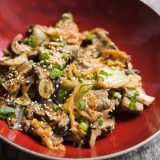Kimchi—Korea’s spicy, fermented cabbage—is most often eaten raw as a condiment or side. But we were intrigued by a recipe that cooked it, using it as a one-stroke solution to add complex flavors to a simple dish.
In Japanese izakayas (pubs), buta kimchi is a popular tapas-style dish in which the cabbage adds punch to a savory-sweet pork belly stir-fry. The pork is briefly marinated, then browned in oil. The kimchi and some of its brine are added to the pan along with soy sauce, sake and scallions.
Kimchi is made from a mix of salted vegetables—often napa cabbage and daikon radish—that’s seasoned with Korean chili powder, garlic, scallions and fish sauce or dried shrimp before being left to ferment. As an ingredient, it’s potent yet versatile, adding savory-sour flavor and spice. Raw, it also contributes nice crunch to a dish.
In buta kimchi, the cooking is brief, allowing the kimchi just enough time to season the other ingredients without losing its crispness. A quick turn in the hot pan also helps temper some of kimchi’s funkier flavors. The result is a fast recipe with only a few ingredients, but because of kimchi’s outsize impact, the dish is robust.
For Milk Street’s version, we adhered to the one-pan cooking method but included a few more elements to enhance the dish—transforming it from a small plate to a full meal.
First, we switched the cut of pork from belly to tenderloin, which was easier to work with and stayed tender. Halved and sliced into quick-cooking half-moons, the tenderloin soaked up a simple marinade of kimchi juice, soy sauce and pepper.
We stir-fried the pork in very hot oil, then set it aside and used the same skillet to sauté shiitake mushrooms and garlic. After returning the pork to the pan, we stirred in the kimchi. The mixture needed to cook only long enough to heat the kimchi, keeping it crisp.
For a final shot of flavor, we used toasted sesame oil, a staple ingredient in Korean and Japanese cooking. Stirred into the dish at the end, it added a nuttiness that we rounded out with toasted sesame seeds for a bit more texture. An entire bunch of chopped scallions—half stirred into the warm pan, the other half sprinkled as a garnish—added freshness and a hint of color.

Kimchi is arguably the most essential food in the Korean pantry. By some estimates, Koreans consume nearly 31/2 ounces of kimchi per day. At Milk Street, we don’t usually manage quite that volume, but still consider it a go-to pantry item. We often:
■ Chop it and stir into roasted potatoes or home fries
■ Blend it with sugar, garlic, rice vinegar, sesame oil and soy sauce, then toss with cold cooked somen noodles
■ Tuck it into lettuce wraps with grilled marinated meat or tofu
■ Chop it finely and mix into ground beef to make kimchi burgers
■ Puree it with a drizzle of sesame oil and use like steak sauce
■ Whisk the juice into mayonnaise for slaw or salad dressing
■ Spoon it onto hot dogs, scrambled eggs and sandwiches
Related Recipes
May-June 2018

Sign up to receive texts
Successfully signed up to receive texts!
We'll only send our very best offers - Like a $15 store credit to start.
By entering your phone number and submitting this form, you consent to receive marketing text messages (such as promotion codes and cart reminders) from Christopher Kimball's Milk Street at the number provided, including messages sent by autodialer. Consent is not a condition of any purchase. Message and data rates may apply. Message frequency varies. You can unsubscribe at any time by replying STOP or clicking the unsubscribe link (where available) in one of our messages. View our Privacy Policy and Terms of Service.



